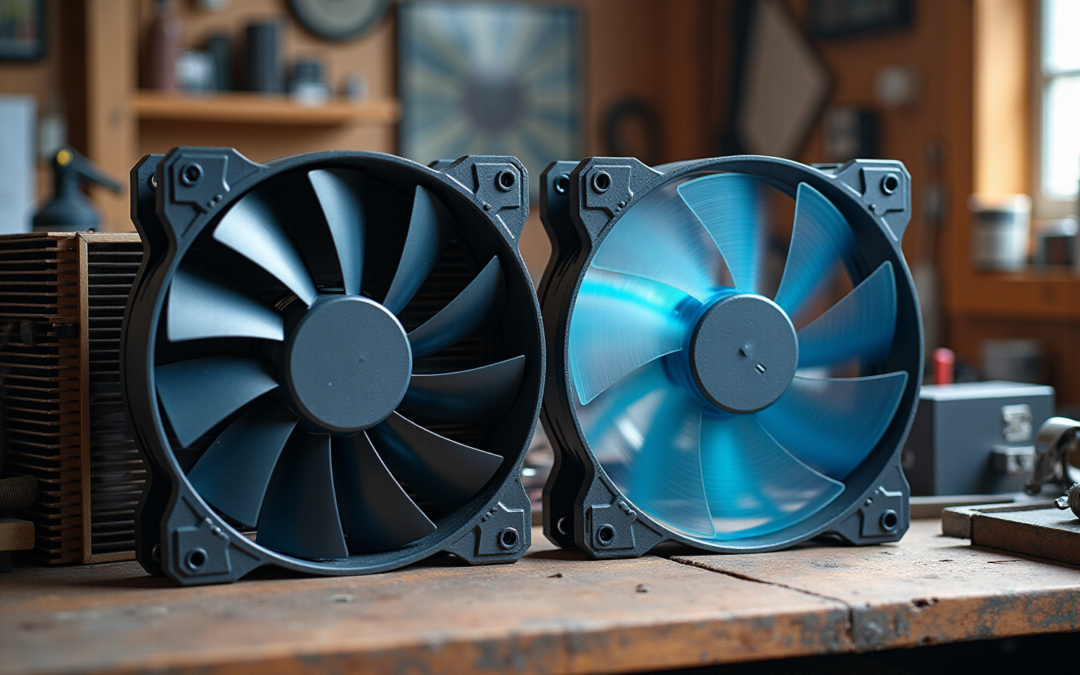Overview
The article examines the distinctions between static pressure and airflow fans, underscoring their respective performance strengths and weaknesses across various cooling applications. It elucidates that static pressure fans thrive in high-resistance environments by generating substantial pressure, whereas airflow fans are more effective in low-resistance settings where rapid air circulation is essential. This analysis emphasizes the critical importance of selecting the appropriate fan type tailored to specific cooling requirements, ensuring optimal performance in diverse scenarios.
Introduction
In the intricate world of cooling systems, the decision between static pressure fans and airflow fans profoundly influences both performance and efficiency. Static pressure fans are meticulously engineered to thrive in environments characterized by high resistance, adeptly overcoming obstacles such as filters and heatsinks. Conversely, airflow fans prioritize volume, providing rapid air circulation in open spaces.
It is essential for engineers to comprehend the strengths and weaknesses inherent in each fan type, as this knowledge is pivotal for optimizing cooling solutions across diverse applications. As technology continues to advance, the subtleties of fan design and performance gain paramount importance. This evolution necessitates a deeper exploration into how these two fan types can be strategically leveraged to effectively meet specific cooling requirements.
Define Static Pressure and Airflow in Fan Systems
Static force is defined as the exertion by air within a system, measured in inches of water column (inH2O). This measurement reflects the resistance that a fan must overcome to move air through various obstacles, such as ducts and filters. In contrast, air movement quantifies the volume of air a fan can move, typically expressed in cubic feet per minute (CFM).
While static pressure is essential in applications with considerable resistance, the movement of air is crucial for settings that require rapid circulation across open spaces. Understanding the differences in static pressure vs airflow fans is vital for engineers when selecting equipment tailored to their specific cooling needs.
For instance, devices designed for high air movement are constructed to transport greater amounts of unrestricted air over a wider space, making them suitable for open environments. Conversely, fans designed for significant static resistance excel in overcoming obstacles, which is essential in scenarios with limited air movement routes.
This duality is critical in cooling applications, especially when considering static pressure vs airflow fans, where both metrics significantly influence performance.
Gagner-Toomey Associates, the largest producer of standard and custom air-movers globally, emphasizes both airflow and static force in their fan designs. Their extensive portfolio includes DC input tube axial ventilators and centrifugal blowers, all utilizing advanced technology and innovative design to ensure superior cooling solutions that enhance performance across diverse applications.
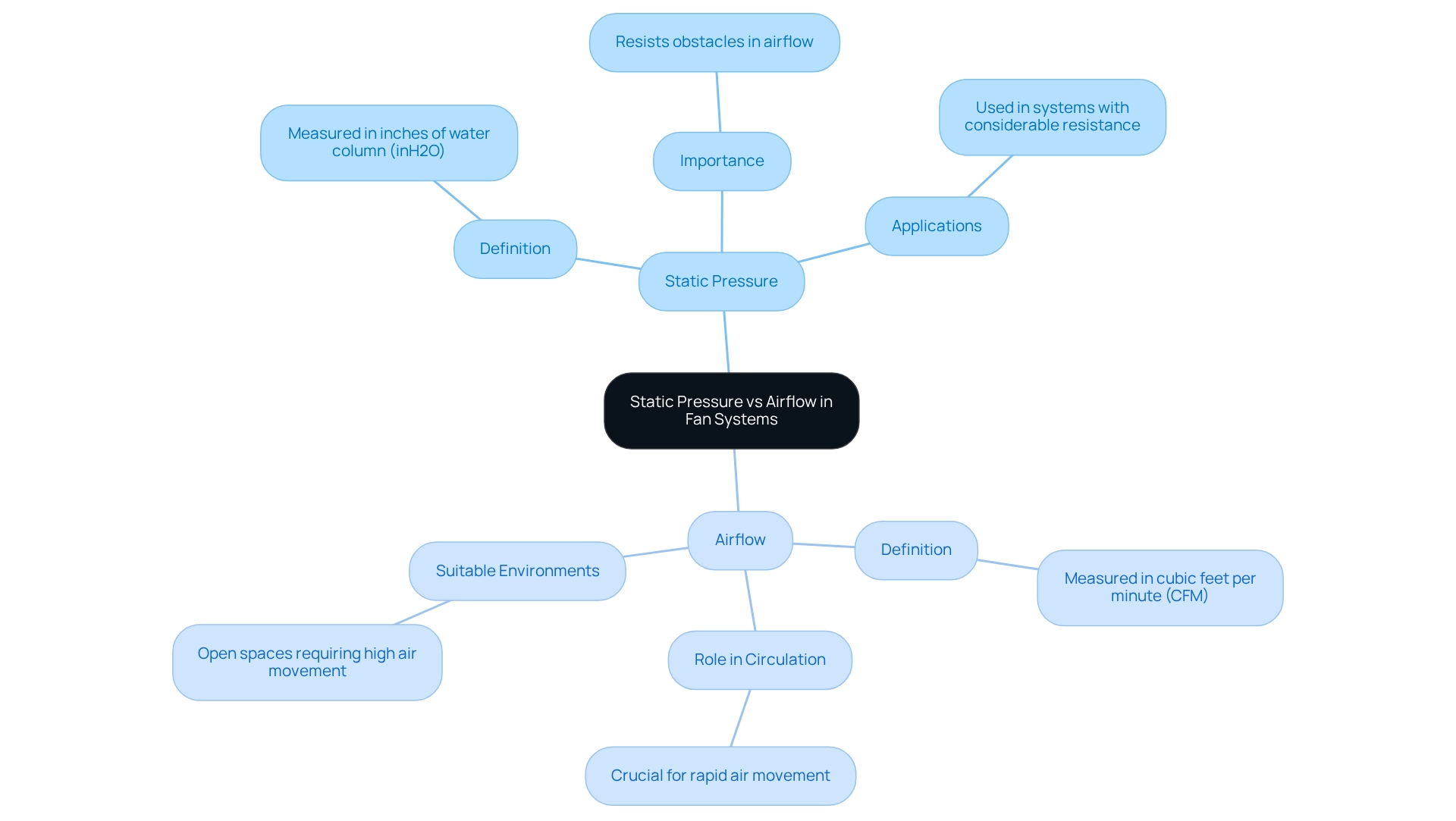
Evaluate Performance of Static Pressure Fans
Static fans are specifically engineered to create high force, making them ideal for moving air through restrictive environments. Their blade designs prioritize force creation over sheer air movement capacity, leading to notable force ratings—often around 3.0 inH2O. This capability enables efficient air movement through dense filters or heatsinks, which is essential in situations where air movement is hindered. However, it is crucial to recognize that in the comparison of static pressure vs airflow fans, the former excel at overcoming resistance but typically display lower air movement ratings compared to conventional fans. This limitation can impact their effectiveness in scenarios demanding high air movement.
For instance, a recent analysis of fan performance data revealed that fan size alone does not determine capacity or performance. The research highlighted the importance of assessing airflow needs at specific levels of static pressure vs airflow fans to ensure optimal ventilation efficiency. Significantly, at a constant force of 0.05 inH2O, the performance statistic indicates an efficiency of 21.11 cfm/W, underscoring the necessity of selecting the appropriate fan for particular applications. In constrained settings, such as those encountered in electronics cooling scenarios, the advantages of static airflow devices become evident. They can maintain adequate ventilation and prevent heat stress, which is critical for the longevity and reliability of electronic components. Proper fan selection can also avert decreased ventilation and associated heat stress in various applications, including barns.
Furthermore, advancements in static airflow fan technology in 2025 have led to enhanced designs that improve both efficiency and noise reduction. Engineers have noted that optimizing fan size, speed, and installation location can significantly minimize unwanted noise while maximizing performance. As one engineer pointed out, “I’ve seen rooftop fan filters in energy storage systems fail due to sand buildup,” highlighting the importance of proper maintenance and selection in restrictive environments. It is also essential to acknowledge that not all 12-inch devices perform uniformly; variability in design and specifications can result in significant differences in performance. As the electronics sector continues to advance, engineers will find it crucial to understand the performance traits and applications of static pressure vs airflow fans for creating efficient cooling solutions.
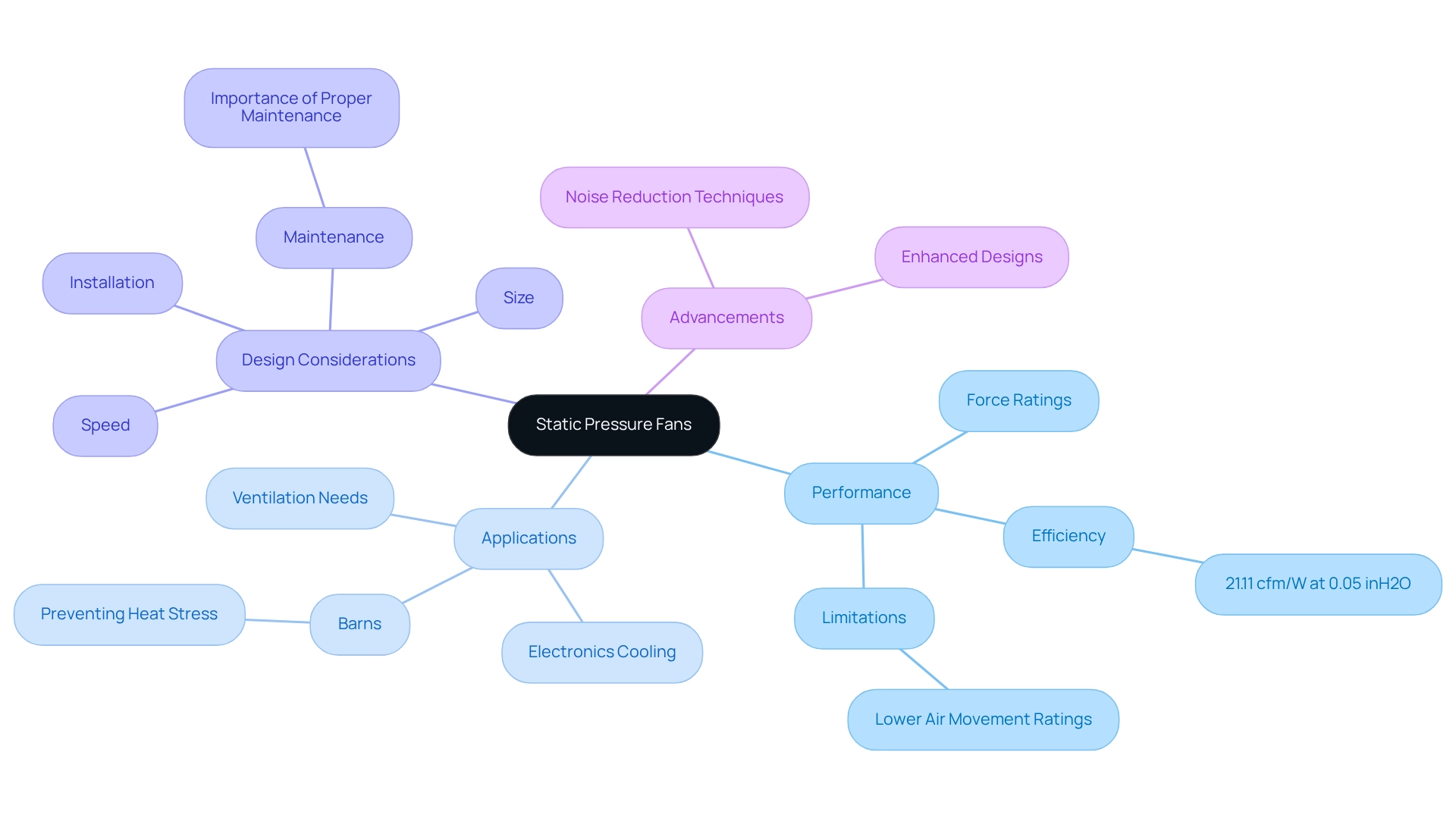
Assess Performance of Airflow Fans
Airflow units are engineered to optimize air circulation, particularly effective in low-resistance environments such as cooling computer cases. These fans often feature impressive CFM ratings, frequently surpassing 100 CFM, which facilitates the swift movement of substantial air volumes. However, it is crucial to recognize that the actual airflow in most forced air cooling applications typically reaches about half of the fan’s maximum output.
The blade design is meticulously crafted to foster a streamlined flow path, thereby enhancing efficiency in open settings. In scenarios characterized by significant resistance, ventilation devices may encounter challenges due to their lower static pressure ratings, especially when analyzing static pressure vs airflow fans, which are generally around 1.0 inH2O. This constraint can impede their capacity to effectively push air through various obstacles.
As Johann Tang, a Product Specialist at Oriental Motor USA Corp., noted, “Unfortunately, we do not produce a fan with 8,000 CFM output,” which underscores the practical limitations inherent in ventilation capabilities. Consequently, engineers are required to rigorously assess the cooling demands of their systems to ascertain the appropriateness of ventilation devices.
For instance, a case study on ceiling devices revealed that selecting products based on coverage area rather than solely on CFM can significantly enhance performance in maintaining comfortable temperatures. This observation underscores the importance of understanding air movement dynamics across different applications, especially in electronic cooling, where the comparison of static pressure vs airflow fans is essential for optimal performance.
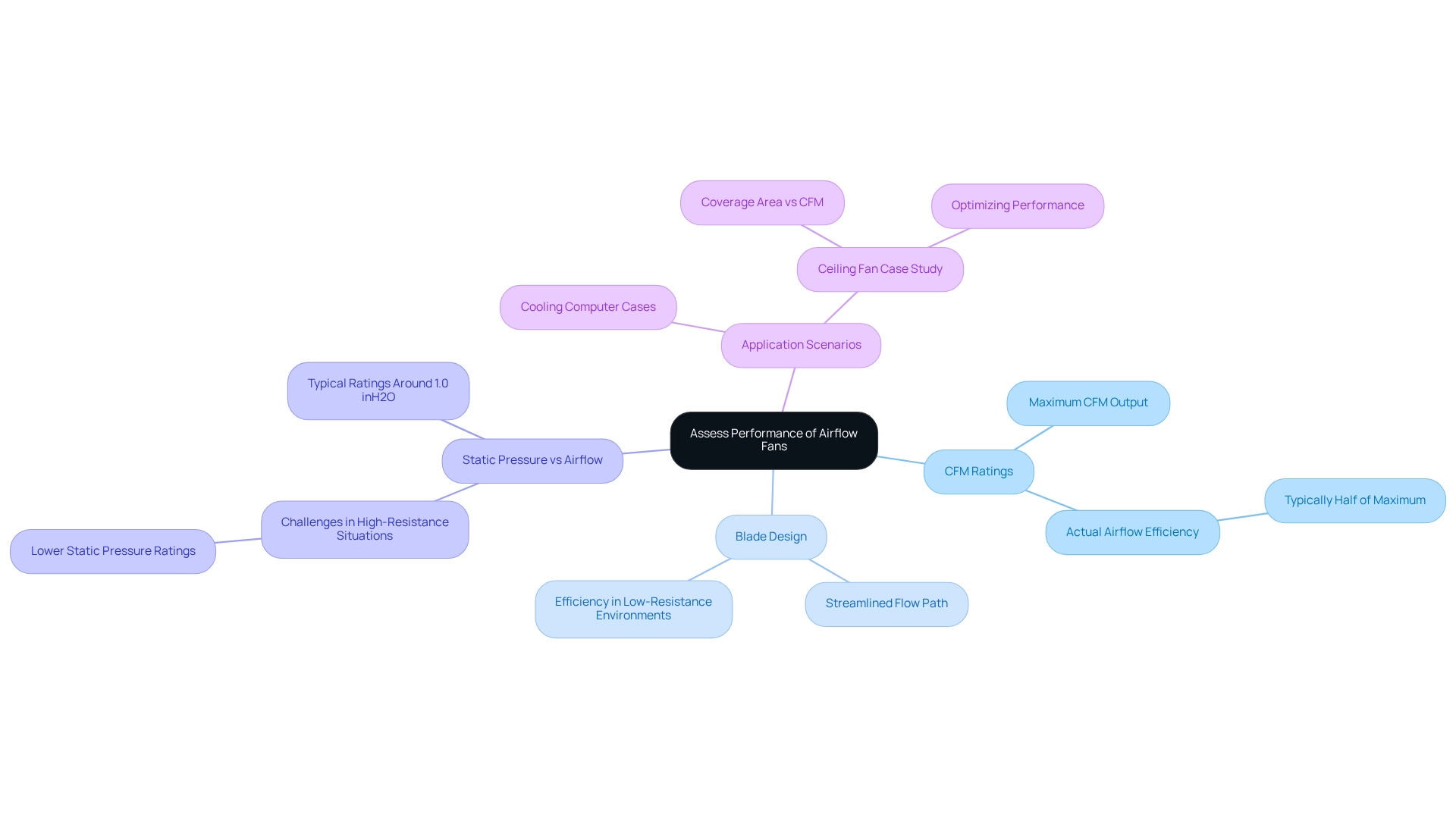
Compare Static Pressure and Airflow Fans: Strengths and Weaknesses
In comparing static pressure vs airflow fans, distinct strengths and weaknesses emerge:
Static Pressure Fans:
- Particularly effective in high-resistance environments, such as those with filters or heatsinks, where their ability to generate pressure is essential.
- Typically operate more quietly under load due to their design, which reduces turbulence.
- Maintain CPU temperatures 3 degrees Celsius cooler than ventilation fans in a radiator setup, as demonstrated in a recent study.
- Ideal for constrained spaces but may have lower ventilation ratings, limiting their effectiveness in scenarios demanding rapid air movement.
Ventilation Fans:
- Excel in open environments where high cubic feet per minute (CFM) is necessary, making them ideal for case cooling applications.
- Promote greater air circulation but often come at the cost of increased noise levels and challenges when faced with resistance.
- Their high CFM capabilities shine in open configurations, making them a viable option despite the cooling performance differences.
Before purchasing a fan, it is wise to clearly define the intended task. Engineers must carefully evaluate the specific cooling requirements of their applications when choosing between these fan types. Ultimately, the decision hinges on balancing the requirements of static pressure vs airflow fans against resistance factors, ensuring optimal performance tailored to the unique demands of each project. Additionally, considerations such as noise levels and power consumption should also be taken into account to make an informed choice.
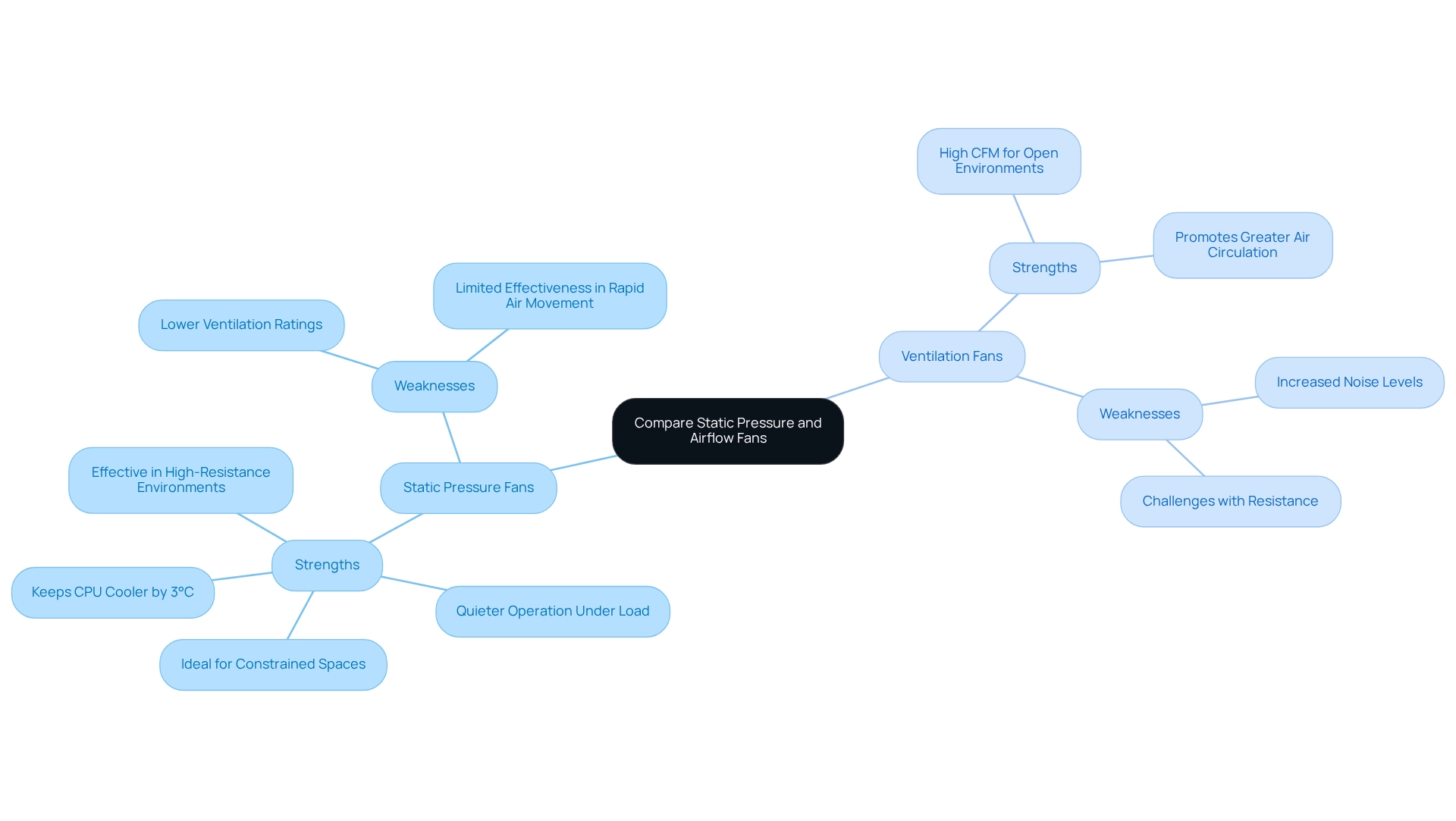
Conclusion
Understanding the distinctions between static pressure fans and airflow fans is essential for engineers striving to optimize cooling solutions across various applications. Static pressure fans are particularly effective in environments characterized by high resistance, such as through filters or heatsinks, as they generate the necessary pressure to maintain adequate airflow. Their design facilitates quieter operation and improved thermal management in constrained spaces. However, their limitations in airflow capacity can be a drawback in scenarios that demand rapid air movement.
Conversely, airflow fans are engineered to maximize air volume, making them ideal for open environments where swift air circulation is crucial. While these fans deliver impressive CFM ratings, their lower static pressure capabilities may impede performance in restrictive settings. This underscores the necessity of meticulously assessing the specific cooling requirements of each application to ensure the appropriate fan type is selected.
In conclusion, the decision between static pressure and airflow fans should be guided by a thorough understanding of the unique demands of the intended environment. Balancing airflow needs with resistance factors, alongside considerations for noise and power efficiency, will guarantee optimal performance. As technology continues to evolve, engineers must remain adaptable in their strategies, leveraging the strengths of each fan type to enhance cooling solutions across diverse applications.
Frequently Asked Questions
What is static force in the context of fans?
Static force is defined as the exertion by air within a system, measured in inches of water column (inH2O). It reflects the resistance that a fan must overcome to move air through obstacles like ducts and filters.
How is air movement measured and what does it indicate?
Air movement is quantified in cubic feet per minute (CFM) and indicates the volume of air a fan can move. It is crucial for settings that require rapid circulation across open spaces.
Why is it important to understand the difference between static pressure and airflow?
Understanding the differences between static pressure and airflow is vital for engineers when selecting equipment tailored to specific cooling needs, as each metric significantly influences fan performance.
What type of fan is suitable for open environments?
Devices designed for high air movement are constructed to transport greater amounts of unrestricted air over wider spaces, making them suitable for open environments.
What characteristics do fans designed for significant static resistance possess?
Fans designed for significant static resistance excel in overcoming obstacles, which is essential in scenarios with limited air movement routes.
How do static pressure and airflow metrics affect cooling applications?
Both static pressure and airflow metrics are critical in cooling applications, as they significantly influence the performance of fans in different environments.
Who is Gagner-Toomey Associates and what do they emphasize in their fan designs?
Gagner-Toomey Associates is the largest producer of standard and custom air-movers globally. They emphasize both airflow and static force in their fan designs, offering advanced technology and innovative solutions for diverse applications.

